Rio Tinto Bundle
How did a Spanish copper mine become a global mining giant?
Uncover the fascinating Rio Tinto SWOT Analysis and its journey from a modest copper mining venture to a global powerhouse. The story of Rio Tinto is a compelling narrative of ambition, innovation, and strategic expansion within the dynamic world of mining. Explore the Rio Tinto history and discover the pivotal moments that shaped this industry leader.
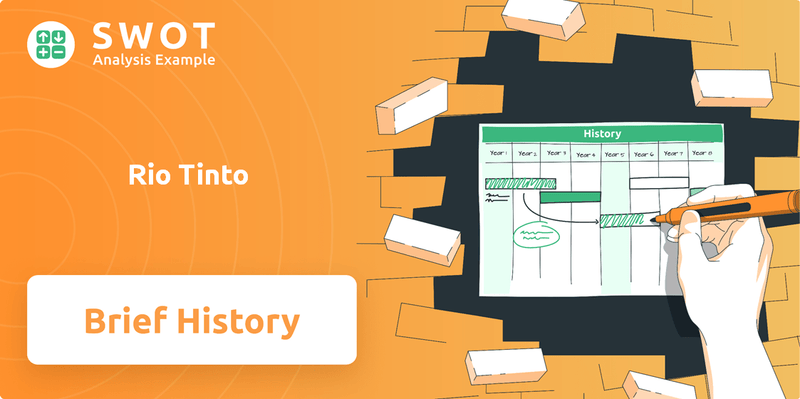
From its Rio Tinto company founding in 1873, the brief history Rio Tinto reveals a remarkable transformation. Initially focused on copper mining in Spain, the company strategically diversified its operations, expanding its reach across continents and into various essential resources. Understanding the history of mining is crucial to grasp the evolution of this multinational corporation.
What is the Rio Tinto Founding Story?
The Rio Tinto company, a global leader in the mining industry, has a rich and complex history. Its origins trace back to the 19th century, with its formal registration in London marking a pivotal moment in the history of mining.
This brief history of Rio Tinto begins with the acquisition of the Rio Tinto mines in Spain. These mines, with a history stretching back to ancient civilizations, were the cornerstone of the company's early operations. The founders recognized the untapped potential of these historic sites, setting the stage for the company's future growth.
The Rio Tinto Company was officially established on March 29, 1873, in London. This followed the Spanish government's sale of the Rio Tinto mines in 1869.
- Hugh Matheson, a Scottish banker, led the group that won the bid.
- Heinrich Doetsch and Wilhelm Sundheim provided the technical expertise.
- The initial focus was on extracting and processing copper.
- The mines were purchased for approximately £3.68 million.
The Rio Tinto company's formation was a direct result of the Spanish government's decision to sell the Rio Tinto mines. Advertisements for the sale appeared across Europe in 1871, attracting a group of businessmen eager to capitalize on the opportunity. Hugh Matheson, the Scottish head of a London bank, spearheaded the winning bid. While Matheson became the inaugural Chairman, the technical vision was provided by Heinrich Doetsch and Wilhelm Sundheim, who already had experience in Spanish mining ventures.
The founders identified the under-exploited potential of the Rio Tinto mines, which had been mined since around 3000 BC. The original business model centered on the large-scale extraction and processing of copper. The company quickly became a leading global producer of copper. The consortium, which included the Rothschild and Goldschmidt families, acquired the mines for approximately £3.68 million. This investment was a significant seed round for the venture. The name 'Rio Tinto,' meaning 'red river,' reflected the distinctive color of the river due to centuries of mining activity. The company also immediately began constructing a railroad to connect the mines with the port of Huelva, demonstrating an early commitment to integrated operations.
Rio Tinto SWOT Analysis
- Complete SWOT Breakdown
- Fully Customizable
- Editable in Excel & Word
- Professional Formatting
- Investor-Ready Format
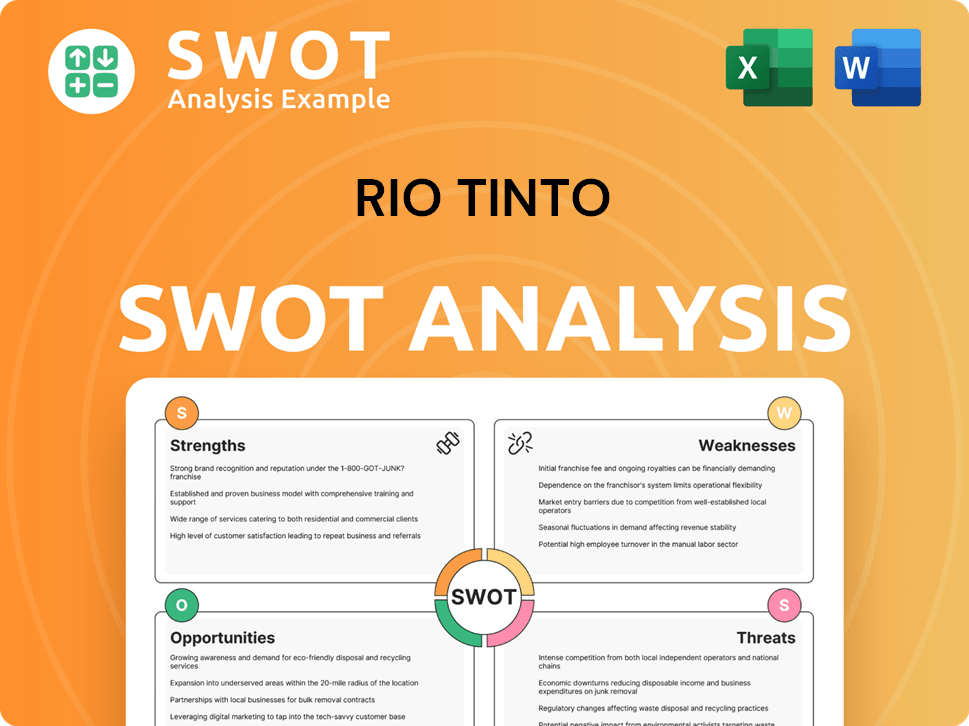
What Drove the Early Growth of Rio Tinto?
The early growth and expansion of the Rio Tinto company were marked by rapid development and strategic diversification. Following its founding, the company quickly scaled up its mining operations and built new processing facilities. This period saw significant innovation in mining techniques. The company's expansion strategy shifted from solely exploiting its Spanish operations to investing in Africa and other regions.
Between 1877 and 1891, the Rio Tinto Mine became the world's leading copper producer. The company initially focused on fully utilizing its Spanish operations. It then began diversifying and investing in Africa in the 1920s, acquiring mines in British colonies, particularly in Northern Rhodesia around 1928. Spain gradually lost its prominent position within the company's portfolio.
A pivotal moment occurred in 1962 with the merger of The Rio Tinto Company and the London-based Consolidated Zinc Corporation (CZ), forming The RTZ Corporation (later renamed Rio Tinto PLC). Simultaneously, the Australian interests of both merged entities formed Conzinc Riotinto of Australia Limited (CRA Limited). This merger transformed the company into an Anglo-Australian entity. The 1989 acquisition of BP Minerals, including Kennecott Corporation, made it one of the world's largest gold producers outside South Africa.
Key developments included the expansion of copper operations with a joint venture for the Minera Escondida mine in Chile and the Neves Corvo copper and zinc mine in Portugal in 1985. By the mid-1990s, RTZ and CRA unified, operating as a single entity with dual listings in the UK and Australia, forming one of the world's largest mining groups. In 2000, Rio Tinto further strengthened its resource base with $4 billion in acquisitions of major aluminum, iron ore, diamonds, and coal assets, including North Ltd. of Australia.
This continuous expansion and strategic diversification allowed the Rio Tinto company to adapt to the competitive landscape and solidify its position as a global mining leader. The company's history reflects a pattern of strategic acquisitions and mergers. These actions have enabled it to grow significantly over time. As of 2024, Rio Tinto's revenue was approximately $54 billion, demonstrating its sustained growth and impact in the mining industry.
Rio Tinto PESTLE Analysis
- Covers All 6 PESTLE Categories
- No Research Needed – Save Hours of Work
- Built by Experts, Trusted by Consultants
- Instant Download, Ready to Use
- 100% Editable, Fully Customizable
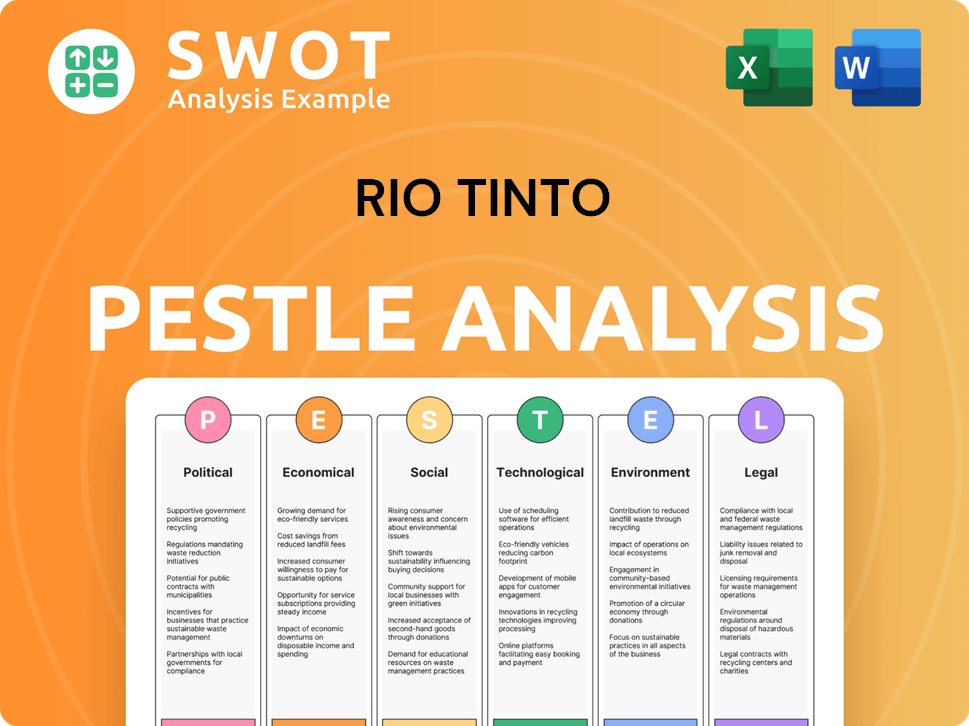
What are the key Milestones in Rio Tinto history?
The brief history of Rio Tinto is marked by significant achievements, starting with its rise to become the world's leading copper producer. This Rio Tinto company has evolved from its Spanish origins to a global mining giant, facing numerous challenges and adapting to the changing demands of the industry. Understanding the Rio Tinto history provides valuable insights into its strategic decisions and operational adjustments over time.
| Year | Milestone |
|---|---|
| 1873 | The company was established, taking over the Rio Tinto mines in Spain. |
| 1877-1891 | Rio Tinto became the world's leading copper producer. |
| 1954 | The company sold its Spanish operations due to the challenges of the Spanish Civil War and World War II. |
| 2007 | Rio Tinto acquired Alcan, significantly expanding its aluminum operations. |
| 2024 | The company continues to focus on sustainable mining and the energy transition. |
Rio Tinto has consistently embraced innovation to improve its operations. Early on, the company adopted new processing facilities and mining techniques to enhance efficiency. More recently, the company is focused on developing new technologies to enhance safety, productivity, and environmental performance.
Early adoption of new processing facilities helped increase production and efficiency. This was a key factor in the company's early success in the copper market.
The company has always been at the forefront of adopting advanced mining techniques. These techniques improved extraction rates and reduced operational costs.
Rio Tinto is developing direct lithium extraction technologies that reduce water usage by approximately 50% compared to traditional methods. This is part of the company's commitment to environmental sustainability.
The company is investing in renewable energy to decarbonize its operations, with projects like the Gudai-Darri solar farm in the Pilbara. This initiative supports the company's net-zero carbon emissions goal by 2050.
Despite its successes, Rio Tinto has faced various challenges throughout its history. Market downturns and operational issues have impacted its performance. The company has also had to navigate complex issues related to social license and environmental concerns.
In 2024, the iron ore price was 11% lower, impacting underlying EBITDA. However, higher prices for copper, bauxite, and aluminum partially offset this.
Extreme weather events in the Pilbara have affected production, requiring the company to adapt its operational strategies. These events highlight the need for resilient supply chains.
The Juukan Gorge incident led to increased scrutiny of cultural heritage management, highlighting the importance of community relations. This event underscored the need for improved stakeholder engagement.
The company's environmental record has faced scrutiny, prompting investments in sustainable practices. This includes efforts to reduce carbon emissions and water usage.
To learn more about the company's financial performance and business model, you can read Revenue Streams & Business Model of Rio Tinto.
Rio Tinto Business Model Canvas
- Complete 9-Block Business Model Canvas
- Effortlessly Communicate Your Business Strategy
- Investor-Ready BMC Format
- 100% Editable and Customizable
- Clear and Structured Layout
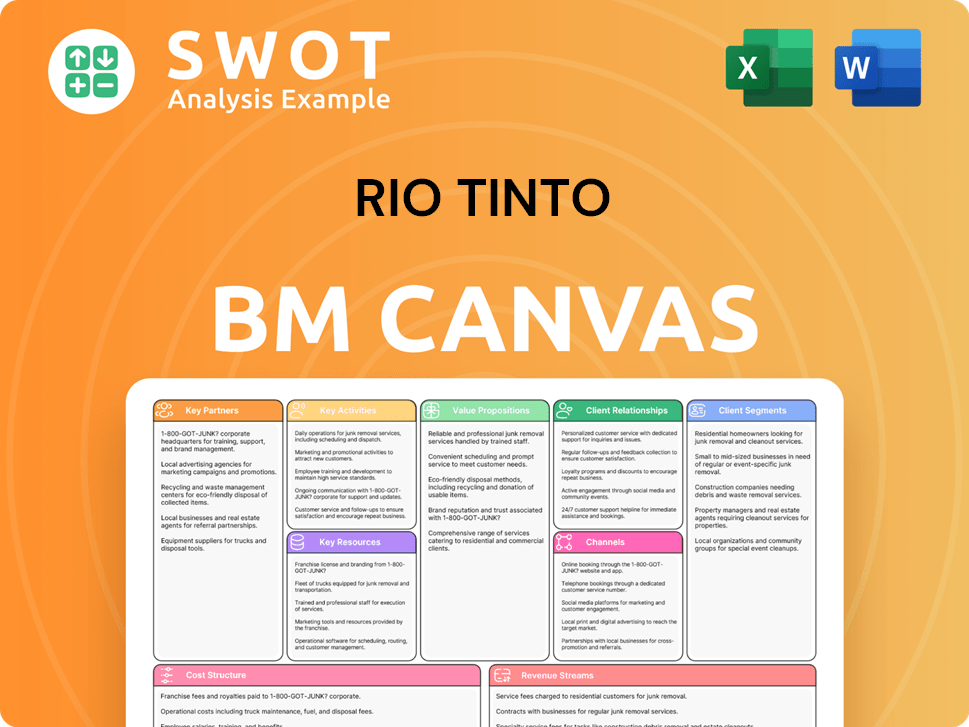
What is the Timeline of Key Events for Rio Tinto?
The Rio Tinto company has a rich history, starting in 1873 with the acquisition of copper mines in Spain. Over time, the company expanded globally, becoming a major player in the mining industry. Key milestones include significant acquisitions, mergers, and a strategic shift towards materials essential for the energy transition. The company's evolution reflects its adaptability and commitment to long-term growth.
| Year | Key Event |
|---|---|
| 1873 | The Rio Tinto Company is formed in London, acquiring copper mines in Spain. |
| 1877-1891 | The Rio Tinto Mine becomes the world's leading copper producer. |
| 1920s | Diversification and expansion into African mining, particularly in Northern Rhodesia. |
| 1954 | Sale of Spanish operations due to political and economic context. |
| 1962 | The Rio Tinto Company merges with Consolidated Zinc Corporation to form RTZ Corporation, establishing the Anglo-Australian dual-listed structure. |
| 1985 | Expansion of copper operations with joint ventures in Chile (Minera Escondida) and Portugal (Neves Corvo). |
| 1989 | Acquisition of BP Minerals, including Kennecott Corporation, significantly expanding gold production. |
| 1995 | RTZ and CRA Limited unify, creating one of the world's largest mining companies. |
| 1997 | RTZ-CRA Group officially changes its name to Rio Tinto PLC. |
| 2000 | Acquires North Ltd. and Ashton Mining, adding major aluminum, iron ore, and diamond assets. |
| 2007 | Acquires Canadian aluminum producer Alcan Inc., becoming a global leader in aluminum. |
| 2024 | Reports underlying EBITDA of $23.3 billion and net earnings of $11.6 billion. |
| 2025 (Q1) | Establishes Rio Tinto Lithium following the acquisition of Arcadium Lithium, aiming for battery-grade lithium production. First production at Simandou iron ore project in Guinea is on track. |
Rio Tinto is strategically expanding its portfolio to include materials vital for the low-carbon economy, such as copper, aluminum, and lithium. The acquisition of Arcadium Lithium further strengthens its position in the lithium market. This shift aligns with the growing demand for materials essential for renewable energy and electric vehicles.
The company anticipates significant growth in copper production, with the Oyu Tolgoi mine expected to ramp up to 500 thousand tonnes of copper per year by 2028. The North Rim Skarn underground copper mine in Utah is also set to begin production, increasing output over two years. Rio Tinto is aiming for around 3% compound annual growth in copper equivalent production from 2024 to 2028.
With the acquisition of Arcadium Lithium, Rio Tinto is targeting 460,000 tonnes of lithium carbonate equivalent annually by 2035. This focus on lithium positions the company to capitalize on the increasing demand for battery-grade lithium. Global lithium demand could reach 3.7 million tonnes by 2035.
Rio Tinto is committed to reducing its environmental impact, with a target to reduce Scope 1 and 2 emissions by 50% by 2030. The company also aims to achieve net-zero carbon emissions by 2050. This commitment to sustainability underscores its long-term vision and the evolving priorities of the mining industry.
Rio Tinto Porter's Five Forces Analysis
- Covers All 5 Competitive Forces in Detail
- Structured for Consultants, Students, and Founders
- 100% Editable in Microsoft Word & Excel
- Instant Digital Download – Use Immediately
- Compatible with Mac & PC – Fully Unlocked
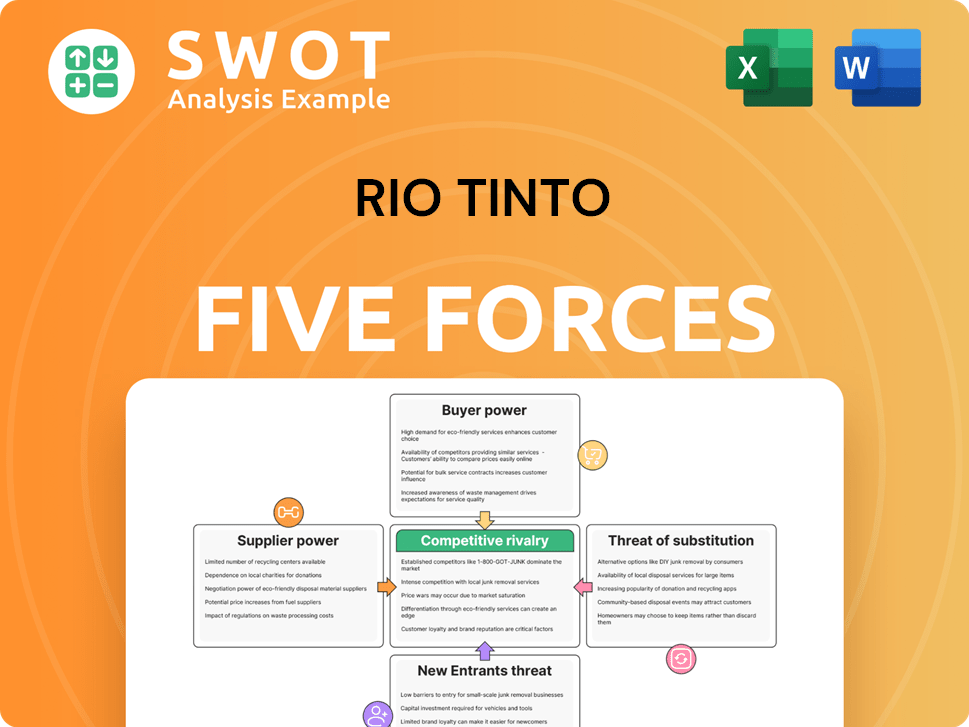
Related Blogs
- What is Competitive Landscape of Rio Tinto Company?
- What is Growth Strategy and Future Prospects of Rio Tinto Company?
- How Does Rio Tinto Company Work?
- What is Sales and Marketing Strategy of Rio Tinto Company?
- What is Brief History of Rio Tinto Company?
- Who Owns Rio Tinto Company?
- What is Customer Demographics and Target Market of Rio Tinto Company?
Disclaimer
All information, articles, and product details provided on this website are for general informational and educational purposes only. We do not claim any ownership over, nor do we intend to infringe upon, any trademarks, copyrights, logos, brand names, or other intellectual property mentioned or depicted on this site. Such intellectual property remains the property of its respective owners, and any references here are made solely for identification or informational purposes, without implying any affiliation, endorsement, or partnership.
We make no representations or warranties, express or implied, regarding the accuracy, completeness, or suitability of any content or products presented. Nothing on this website should be construed as legal, tax, investment, financial, medical, or other professional advice. In addition, no part of this site—including articles or product references—constitutes a solicitation, recommendation, endorsement, advertisement, or offer to buy or sell any securities, franchises, or other financial instruments, particularly in jurisdictions where such activity would be unlawful.
All content is of a general nature and may not address the specific circumstances of any individual or entity. It is not a substitute for professional advice or services. Any actions you take based on the information provided here are strictly at your own risk. You accept full responsibility for any decisions or outcomes arising from your use of this website and agree to release us from any liability in connection with your use of, or reliance upon, the content or products found herein.